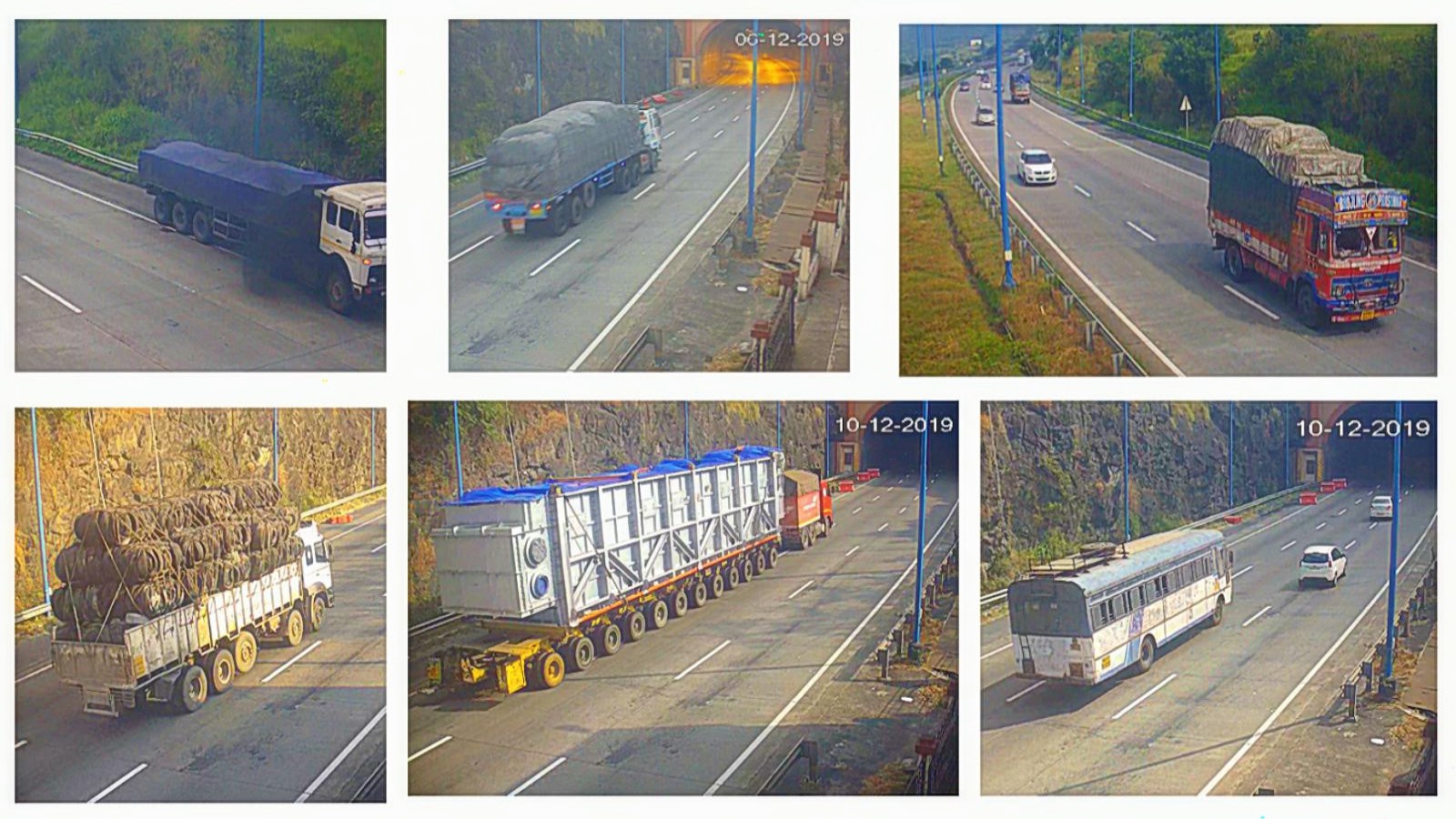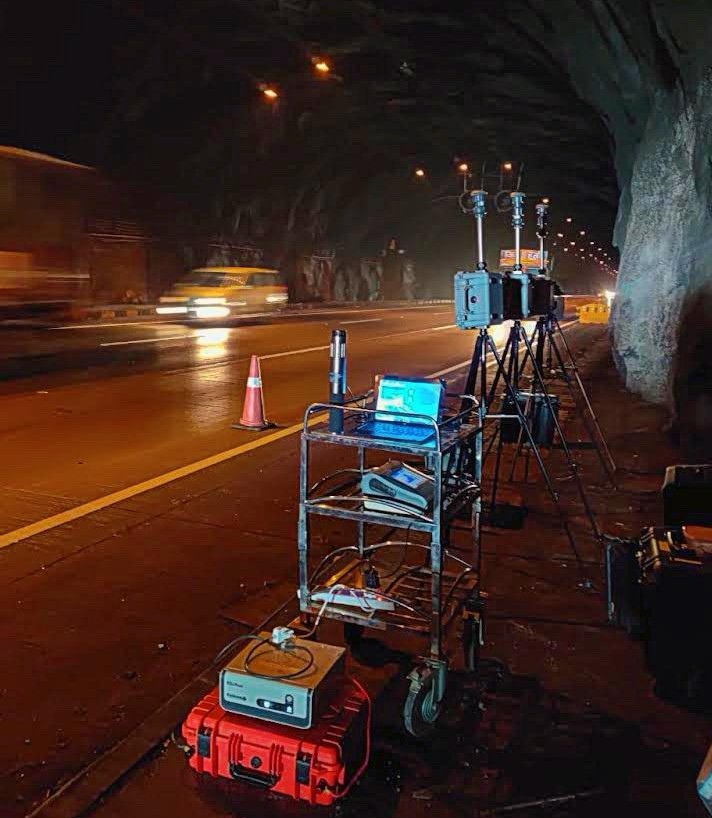Researchers from IIT Bombay study heavy polluters on the Mumbai-Pune Expressway and suggest the need for stringent policies to restrict vehicular pollution.

Few identified super-emitters from the study. Credit: Authors of the study
The year 2023 shocked the globe as the hottest year in recorded history. The last 12 months have experienced the highest monthly temperatures ever recorded, and it looks like it is only going to get worse from here. With every passing year, the realities of climate change are being experienced globally, and the need for comprehensive climate action has never been greater. Air pollution, particularly airborne particles, contributes to climate and is associated with adverse health effects. According to the Global Burden of Disease Study (GBD, 2021), 16.7 lakh deaths have been attributed to air pollution in India.
Emissions from motor vehicles are major contributors to urban air pollution in India. Rapid urbanisation, leading to an increase in the number of vehicles on the road, is a cause for concern. Congestion increases the time spent on the road, leading to large amounts of fuel being burned, thus resulting in more pollution. However, the polluting characteristics of all vehicles are not the same. Some vehicles release disproportionately higher amounts of pollutants. A recent study from the Indian Institute of Technology, Bombay (IIT Bombay) investigates the factors determining the polluting characteristics of such high-emitting vehicles or super-emitters.
“Until now, there has been no study in India that has examined the share of super-emitters in real-world vehicular fleets. The previous studies assumed their share based on literature from other countries or secondary data. The motivation was to reduce uncertainty in the emission estimation from real-world vehicular fleets,” says Ms Sohana Debbarma, a researcher from the study who worked under the guidance of Prof Harish Phuleria and Prof Chandra Venkataraman.
Super-emitters are vehicles that are either old, poorly maintained, over-loaded heavy-duty vehicles or all of them. They release significantly higher amounts of pollutants compared to the other vehicles in the fleet. According to the IIT Bombay study, for light-duty vehicles (vehicles that weigh less than 3,500 kg such as cars, two-wheelers, three-wheelers, and light commercial goods vehicles), the age of the vehicles and the maintenance of the engine potentially determines whether the vehicle is a super-emitter. In the case of heavy-duty vehicles (vehicles that weigh more than 3,500 kg, such as buses and trucks), the overloading condition, along with the age and maintenance of the vehicles, contribute to the disproportionately high pollutant emissions.
Roadway tunnels offer ideal conditions for this study because of the confined space within the tunnel, which effectively traps the emissions from the vehicles, barring the influence of other ambient sources. It also has the added advantage of being able to collect data from a large vehicle fleet in a real-world scenario, as opposed to measuring emissions from a limited number of individual vehicles in a controlled environment in testing laboratories.
To conduct the study, the researchers set up their pollutant-measuring equipment at the entry and exit of the Kamshet-I tunnel located on the Mumbai-Pune Expressway. Along with exhaust emissions (resulting from incomplete combustion of fossil fuels), non-exhaust emissions (resulting from brake wear, tyre wear, road surface wear, and resuspension of road dust) were also collected. The traffic data was collected using high-definition video cameras and the vehicle registration numbers data (collected manually). The study collected data over two weeks.
The researchers identified super-emitters through manual inspection based on the video surveillance records of the traffic passing through the tunnel. Vehicles that emitted a visible plume of smoke or appeared to be overloaded were identified as super-emitters. It was also validated using the information on the age of the vehicles and type of emission technology: Bharat Stages (BS) - II, III, and IV (the study was conducted in 2019 when there were no BS VI vehicles) and the type of fuel (petrol, diesel, and CNG).

The researchers observed that the pollutant levels at the exit of the tunnel were significantly higher than those at the entry, and the tunnel exit captured the true signature of the vehicular emissions. While the traffic flow was the major determinant of pollutants at the exit, other surrounding factors influenced the pollutant levels at the entry, such as biomass burning from the neighbouring village. However, determining the difference in pollutant levels between the entry and the exit helped to effectively capture the impact of the traffic flow on the measured pollutant levels.
The IIT Bombay researchers estimated that super-emitters constituted an average of 21%(±3%) of the total vehicle fleet in the Kamshet-I tunnel, where 10%(±2%) of the fleet had a visible plume of smoke and 11%(±2%) were overloaded freight vehicles. The team developed a mathematical model to predict the share of super-emitters in any given real-world traffic in India by factoring in the shares of heavy-duty vehicles and light-duty vehicles, their respective ages, and fuel composition.
Old vehicles with engines that don’t comply with modern emission technologies and poor maintenance of relatively new vehicles could lead them to become potential super-emitters. Overloaded vehicles, especially heavy-duty vehicles, require additional fuel to power the vehicle,leading to the release of higher pollutant emissions. Additionally, overloaded vehicles also cause higher non-exhaust emissions due to the higher road surface friction while moving. The Vehicle scrappage policy in India focuses on the scrapping of private and commercial petrol vehicles more than 15 years old and diesel vehicles more than 10 years old. However, the researchers did not find strict enforcement of these policies. Moreover, some of the relatively newer vehicles, likely due to poor maintenance, can lead to disproportionate pollution from a significant portion of vehicles in India.
The IIT Bombay study has highlighted the importance of enforcing strict regulations along with strengthening vehicle inspection and maintenance programs on India’s vehicle fleet with respect to super-emitters and their disproportionate release of pollutants. With over one-fifth of the vehicles in India being estimated to be potential super-emitters, it is high time the authorities take action. According to the Voluntary Vehicle Fleet Modernization Program (VVMP) published by the Ministry of Road Transport and Highways, the replacement of vehicles at the end of their lives will reduce vehicular pollution by 15-20%. However, this alone will not be sufficient because even a relatively new heavy-duty vehicle can be a super-emitter if loaded beyond its capacity or poorly maintained.
Recently, Nitin Gadkari, the Union Minister for Road Transport and Highways, has expressed an intention to completely phase out petrol and diesel vehicles and adopt alternatives, such as electric vehicles (EVs). The Union Government has created multiple incentives for both industries and consumers to promote the adoption of EVs in India.
“While the exhaust emissions can be controlled with the introduction of EVs, the non-exhaust emissions will still be of concern. There are still no emission standards for non-exhaust emissions in India,” concluded Ms Debbarma.
